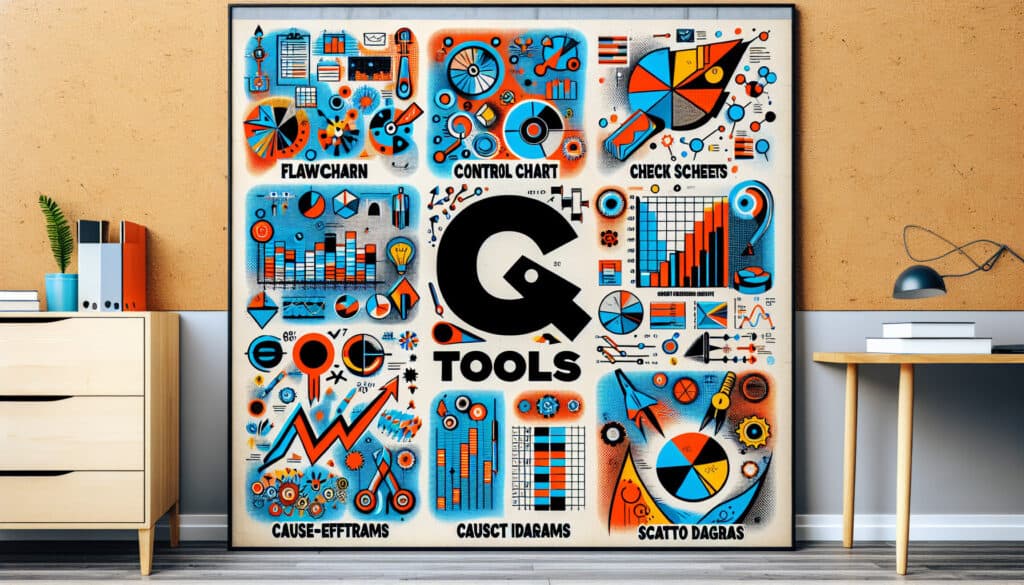A set of fundamental, graphical, and statistical tools for quality control and improvement.
- Metodologías: Clientes y marketing, Economía
7 Herramientas de control de calidad

7 Herramientas de control de calidad
- Mejora continua, Gráfico de control, Diagrama de Pareto, Técnicas de resolución de problemas, Mejora de procesos, Seguro de calidad, Control de calidad, Gestión de calidad, Sistema de Gestión de Calidad (SGC)
Objetivo:
Cómo se utiliza:
- These tools are used to collect, analyze, and interpret data to solve quality-related problems. They include tools like Pareto charts, fishbone diagrams, control charts, and histograms.
Ventajas
- Simple to use, provides a structured approach to problem-solving, and facilitates data-driven decision-making.
Contras
- May not be sufficient for complex statistical analysis, and their effectiveness depends on correct application and interpretation.
Categorías:
- Lean Sigma, Fabricación, Resolución de problemas, Calidad
Ideal para:
- Identifying and resolving most quality problems in a production environment.
The 7 QC Tools methodology finds applications across various industries such as manufacturing, healthcare, and service sectors, enabling teams to systematically address and resolve quality issues by leveraging practical data analysis techniques. In a manufacturing context, for instance, a team may apply Pareto charts to identify the most frequent defects, directing efforts toward the most significant problems that impact production efficiency. Fishbone diagrams can be utilized during brainstorming sessions to uncover root causes of quality failures, facilitating collaborative problem-solving among cross-functional teams including engineers, quality assurance, and production staff. Control charts are integral in monitoring processes over time, helping practitioners to maintain quality standards by identifying variances that may signal underlying issues. Histogram analyses support the visualization of data distribution, revealing patterns about production consistency and potential areas for improvement. Typically, these methodologies are employed in the quality improvement phase of projects, often initiated by quality managers or team leaders who engage stakeholders throughout the organization. Training sessions on these tools equip participants with the necessary skills to analyze quality issues in real-time, enabling rapid decision-making based on empirical evidence rather than assumptions. Using the 7 QC Tools promotes a culture of continuous improvement, encourages open communication, and empowers teams to take ownership of quality enhancement initiatives.
Pasos clave de esta metodología
- Identify the quality problem to focus on.
- Utilize a Pareto chart to prioritize issues based on frequency or impact.
- Employ a fishbone diagram to analyze root causes of the identified problem.
- Use a scatter diagram to identify relationships between variables.
- Implement control charts to monitor process performance over time.
- Create histograms to visualize the distribution of data related to the issue.
- Conduct a failure mode and effects analysis (FMEA) to evaluate potential failures.
- Use a check sheet to collect qualitative and quantitative data during analysis.
Consejos profesionales
- Integrate real-time data monitoring with control charts to identify trends as they develop, enabling proactive quality management.
- Utilize multi-dimensional fishbone diagrams to dissect root causes from various perspectives, enhancing collaborative analysis among cross-functional teams.
- Combine Pareto analysis with predictive analytics to not only identify major issues but also forecast potential future problems based on historical data patterns.
Leer y comparar varias metodologías, recomendamos el
> Amplio repositorio de metodologías <
junto con otras más de 400 metodologías.
Sus comentarios sobre esta metodología o información adicional son bienvenidos en la dirección sección de comentarios ↓ , así como cualquier idea o enlace relacionado con la ingeniería.
Contexto histórico
1962
1970
1972
1980
1980
1986
1986
1960
1963
1970
1980
1980
1980
1986
1987
(si se desconoce la fecha o no es relevante, por ejemplo "mecánica de fluidos", se ofrece una estimación redondeada de su notable aparición)















Publicaciones relacionadas
Gestión de operaciones de fabricación (MOM)
Sistema de Ejecución de Fabricación (MES)
Plan de control de la fabricación
Pruebas manuales
Tablas de evaluación de la manipulación manual (MAC)
ManTRA (Herramienta de evaluación de riesgos en las tareas manuales)